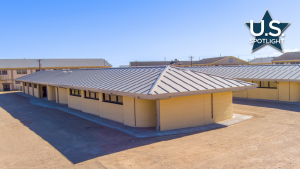An innovative modular homebuilder based in the tiny eastern European country of Kosovo hopes to succeed where U.S. modular homebuilders have failed.
InstaBuilt LLC has announced it will establish its new North American headquarters in East Austin, Texas. From there, the company will deliver factory-built new homes that can be assembled in a matter of hours. After Texas, it intends to expand into Colorado and the U.S. Midwest.
InstaBuilt homes combine panelized systems with volumetric bath pods as well as complete volumetric housing solutions.
“With panels, clients can complete projects up to 60 per cent faster than traditional methods, thanks to prefabricated panels assembled onsite,” the company says. “Module technology takes efficiency to the next level, allowing for 98 per cent factory-based construction, minimizing onsite work and ensuring a high level of precision.”
The decision to launch InstaBuilt’s modular home solution in Whisper Valley, a 2,000-acre subdivision in East Austin, makes sense in many ways due to its forward-thinking outlook. For example, although connected to the state’s electrical grid, all Whisper Valley homes utilize geothermal technology and have solar panels and energy storage systems with the objective of being energy self-reliant.
Prices for InstaBuilt homes reflect another advantage of the factory-built concept. The three home designs on offer range from $200,000 to $400,000, significantly less than the regional median house price of $459,000 recorded this spring.
A prejudice that has dogged modular housing in North America over past decades has been the perception that factory-built houses are cookie-cutter lookalikes. This may be rooted in the image of the simplistic catalogue homes that were built in a hurry to address housing shortages following the First World War. Interestingly, in Canada the housing catalogue concept is now making a comeback, with the encouragement of the federal government.
However, InstaBuilt demonstrates that factory-built homes do not have to be small and boring. The company is offering both traditional American homes as well as contemporary low-level bungalows from its extensive catalogue of designs. Each has several different floorplans. In 2026, the company intends to build a 100-unit multifamily apartment.
It is somewhat ironic that factory-built homes proliferate in Europe and elsewhere and not yet in North America.
Back in 1969, then-secretary of the U.S. Department of Housing and Urban Development, George Romney, led a federal initiative called Operation Breakthrough. The goal was to build 26 million homes in 10 years, triple the output of the previous 10 years.

Sound familiar? Romney argued industrializing home construction was the solution.
Although Operation Breakthrough largely failed in the U.S., other countries took note, particularly Japan and Sweden. Today, 15 per cent of Japanese homes and apartments are factory built, as are 84 per cent in Sweden.
Of the obstacles that have frustrated the development of wide-spread factory-built construction in North America, two of the most-cited have been the fear of disruption to current bespoke home building practices within the industry itself and bottlenecks in the building code and inspection processes.
Richard Lyall, president of the Residential Construction Council of Ontario recently wrote in the Daily Commercial News, calling out Canada for its ranking of 34 out of 35 OECD countries in terms of the time required for regulatory approval of a construction project.
However, despite widely reported statistics indicating a decline of productivity in home construction of 50 per cent over recent decades, Lyall deflected responsibility away from the industry. Instead, he largely blamed the “excessive red tape and inefficient approvals process, along with outdated regulations in many municipalities and exorbitant taxes, fees and levies” for today’s housing shortage.
In fact, one of the major regulatory differences between Sweden and North America is the prescriptive nature of North American codes that require each house to have its own individual building permit. Performance-based codes in Sweden allow builders to find their own solutions to achieving national building standards.
The Kosovo-led experience revealed in Texas may show North America how modular progress can be achieved.
John Bleasby is a freelance writer. Send comments and Inside Innovation column ideas to editor@dailycommercialnews.com.











Recent Comments